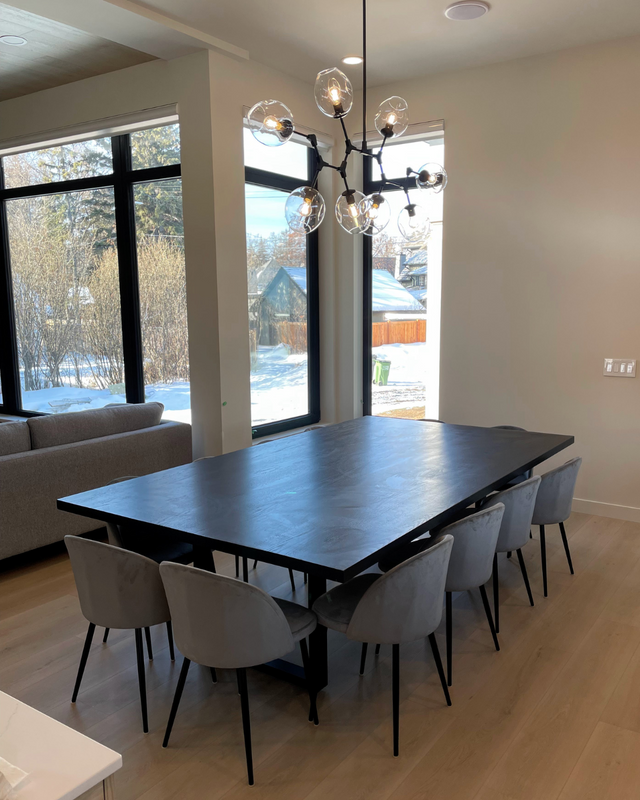Solid Wood vs. Veneer: How to Tell the Difference Before You Buy
Why Your Choice Matters
When shopping for furniture, the decision between solid wood and veneer isn’t just about aesthetics—it’s about durability, longevity, and value. While both materials have their place in furniture design, knowing how to distinguish between them ensures you make the right investment for your home.
This guide will break down the differences between solid wood and veneer, helping you understand how they perform, what to look for, and when to choose one over the other.
What is Solid Wood Furniture?
Solid wood furniture is crafted from 100 percent natural hardwood or softwood, with no composite materials. It’s valued for its durability, timeless beauty, and ability to withstand years of use.
Key Characteristics of Solid Wood:
- Durability: Built to last for decades, even generations
- Refinishing Potential: Can be sanded and restained multiple times
- Unique Grain Patterns: No two pieces are exactly alike
Common Solid Wood Types:
- Walnut – Dark, rich, and sophisticated
- Oak – Strong, classic, and resistant to wear
- Maple – Smooth, light-colored, and modern
Best Use Cases:
Solid wood is ideal for high-use furniture such as dining tables, coffee tables, bookshelves, and bedroom furniture. It’s perfect for those looking for longevity and craftsmanship.
What is Veneer Furniture?
Veneer furniture consists of a thin layer of real wood (veneer) bonded to a core material such as plywood, MDF, or particleboard. While it provides the look of solid wood, its construction differs significantly.
Key Characteristics of Veneer:
- Cost-Effective: Provides the appearance of wood at a lower price
- Lightweight: Easier to move and transport
- Smooth, Consistent Finish: Often used in modern and contemporary designs
Potential Drawbacks of Veneer:
- Less Durable: Prone to chipping, peeling, and water damage
- Cannot Be Refinished: Once damaged, repairs are limited
- Core Material Matters: Quality varies based on what’s underneath the veneer
Best Use Cases:
Veneer is best for budget-conscious buyers looking for stylish, lightweight furniture that won’t need to withstand heavy wear and tear.
How to Tell the Difference: A Practical Guide
1. Check the Edges
- Solid Wood: The grain continues seamlessly from the surface to the edges.
- Veneer: The top layer looks separate from the edges, revealing a different material underneath.
2. Look at the Grain Pattern
- Solid Wood: Natural and varied grain that flows consistently across the surface.
- Veneer: Patterns often repeat, suggesting a printed or laminated surface.
3. Test the Weight
- Solid Wood: Heavier due to its natural density.
- Veneer: Lighter, especially if made with MDF or particleboard.
4. Check for Seams
- Solid Wood: No seams or layers on the surface.
- Veneer: Thin wood layer glued to another material, often visible along the edges.
5. Consider the Price
- Solid Wood: Higher cost, but long-term durability.
- Veneer: More affordable, but may need replacement sooner.
Solid Wood vs. Veneer: Which One Should You Choose?
Choose Solid Wood If You Want:
- Long-term durability with heirloom-quality craftsmanship
- A piece that can be refinished and restored over time
- A natural, unique grain that develops character as it ages
Choose Veneer If You Need:
- A budget-friendly alternative that mimics the look of solid wood
- Lightweight furniture that’s easier to move
- A temporary or trend-driven piece for short-term use
Both options have their place, and the best choice depends on your priorities. If you’re looking for longevity and craftsmanship, solid wood is worth the investment. If affordability and modern aesthetics are your focus, veneer furniture can be a practical solution.
Final Thoughts: Making a Smart Investment
Furniture isn’t just about aesthetics—it’s about function, longevity, and value. Whether you choose solid wood for its strength and timeless beauty or veneer for its affordability and modern appeal, knowing the difference helps you make an informed purchase that suits your home and lifestyle.
Before buying your next piece of furniture, take a closer look at the materials, construction, and long-term durability. Investing wisely ensures you get furniture that not only looks great but also stands the test of time.
For more insights on furniture selection, craftsmanship, and maintenance, explore our latest guides and expert advice.

